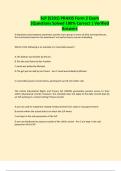Slp 5331 praxis - Study guides, Class notes & Summaries
Looking for the best study guides, study notes and summaries about Slp 5331 praxis? On this page you'll find 24 study documents about Slp 5331 praxis.
Page 2 out of 24 results
Sort by
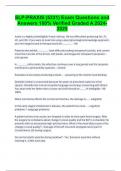
-
SLP-PRAXIS (5331) Exam Questions and Answers 100% Verified Graded A 2024-2025
- Exam (elaborations) • 46 pages • 2024
-
Available in package deal
-
- $15.49
- + learn more
Justin is a highly unintelligible 4-year-old boy. He has difficulties producing /w/, /t/, /d/, and /th/. If you were to treat him using a least phonological knowledge approach, your first target sound in therapy would be:________ - /th/ Patients who exhibit _________ have difficulty making nonspeech sounds, and cannot move the muscles of the throat, soft palate, and tongue for nonspeech purposes: - oral apraxia In ________ otitis media, the infection continues over a long period and the ty...
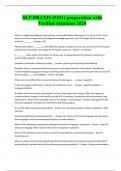
-
SLP-PRAXIS (5331) preparation with Verified Solutions 2024
- Exam (elaborations) • 35 pages • 2024
- Available in package deal
-
- $12.99
- + learn more
SLP-PRAXIS (5331) preparation with Verified Solutions 2024 Justin is a highly unintelligible 4-year-old boy. He has difficulties producing /w/, /t/, /d/, and /th/. If you were to treat him using a least phonological knowledge approach, your first target sound in therapy would be:________ - Answer -/th/ Patients who exhibit _________ have difficulty making nonspeech sounds, and cannot move the muscles of the throat, soft palate, and tongue for nonspeech purposes: - Answer -oral apraxia In ...
BUNDLED SLP-PRAXIS (5331) Exam Questions and Answers 100% Verified Graded A 2024-2025
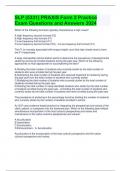
-
SLP (5331) PRAXIS Form 2 Practice Exam Questions and Answers 2024
- Exam (elaborations) • 19 pages • 2024
-
Available in package deal
-
- $15.39
- + learn more
Which of the following formants typically characterizes a high vowel? A.High-frequency second formant (F2) B.High-frequency first formant (F1) C.Low-frequency first formant (F1) D.Low-frequency second formant (F2) - C.Low-frequency first formant (F1) The F1 is inversely associated with tongue height, such that high vowels tend to have low F1 frequencies. A large metropolitan school district wants to determine the prevalence of developmental stuttering among all enrolled students duri...
SLP (5331) PRAXIS Form 2 Exam |Questions Solved 100% Correct | Verified Answers
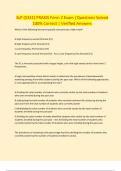
-
SLP (5331) PRAXIS Form 2 Exam |Questions Solved 100% Correct | Verified Answers
- Exam (elaborations) • 27 pages • 2024
- Available in package deal
-
- $12.99
- + learn more
Which of the following formants typically characterizes a high vowel? A.High-frequency second formant (F2) B.High-frequency first formant (F1) C.Low-frequency first formant (F1) D.Low-frequency second formant (F2) - Ans C.Low-frequency first formant (F1)
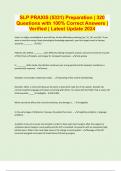
-
SLP PRAXIS (5331) Preparation | 320 Questions with 100% Correct Answers | Verified | Latest Update 2024
- Exam (elaborations) • 42 pages • 2024
- Available in package deal
-
- $14.49
- + learn more
Justin is a highly unintelligible 4-year-old boy. He has difficulties producing /w/, /t/, /d/, and /th/. If you were to treat him using a least phonological knowledge approach, your first target sound in therapy would be:________ - /th/ Patients who exhibit _________ have difficulty making nonspeech sounds, and cannot move the muscles of the throat, soft palate, and tongue for nonspeech purposes: - oral apraxia In ________ otitis media, the infection continues over a long period and the tym...
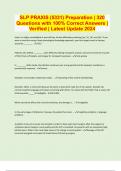
-
SLP PRAXIS (5331) Preparation | 320 Questions with 100% Correct Answers | Verified | Latest Update 2024 | 42 Pages
- Exam (elaborations) • 42 pages • 2023
-
- $20.49
- + learn more
Justin is a highly unintelligible 4-year-old boy. He has difficulties producing /w/, /t/, /d/, and /th/. If you were to treat him using a least phonological knowledge approach, your first target sound in therapy would be:________ - /th/ Patients who exhibit _________ have difficulty making nonspeech sounds, and cannot move the muscles of the throat, soft palate, and tongue for nonspeech purposes: - oral apraxia In ________ otitis media, the infection continues over a long period and the tym...
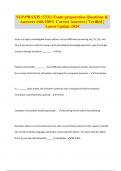
-
SLP-PRAXIS (5331) Exam preparation Questions & Answers with 100% Correct Answers | Verified | Latest Update 2024
- Exam (elaborations) • 82 pages • 2024
- Available in package deal
-
- $14.49
- + learn more
Justin is a highly unintelligible 4-year-old boy. He has difficulties producing /w/, /t/, /d/, and /th/. If you were to treat him using a least phonological knowledge approach, your first target sound in therapy would be:________ - /th/ Patients who exhibit _________ have difficulty making nonspeech sounds, and cannot move the muscles of the throat, soft palate, and tongue for nonspeech purposes: - oral apraxia In ________ otitis media, the infection continues over a long period and the tym...
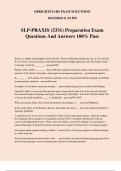
-
SLP-PRAXIS (5331) Preparation Exam Questions And Answers 100% Pass
- Exam (elaborations) • 39 pages • 2024
-
- $12.49
- + learn more
SLP-PRAXIS (5331) Preparation Exam Questions And Answers 100% Pass Justin is a highly unintelligible 4-year-old boy. He has difficulties producing /w/, /t/, /d/, and /th/. If you were to treat him using a least phonological knowledge approach, your first target sound in therapy would be:________ - answer/th/ Patients who exhibit _________ have difficulty making nonspeech sounds, and cannot move the muscles of the throat, soft palate, and tongue for nonspeech purposes: - answeroral apraxia ...

Did you know that on average a seller on Stuvia earns $82 per month selling study resources? Hmm, hint, hint. Discover all about earning on Stuvia

